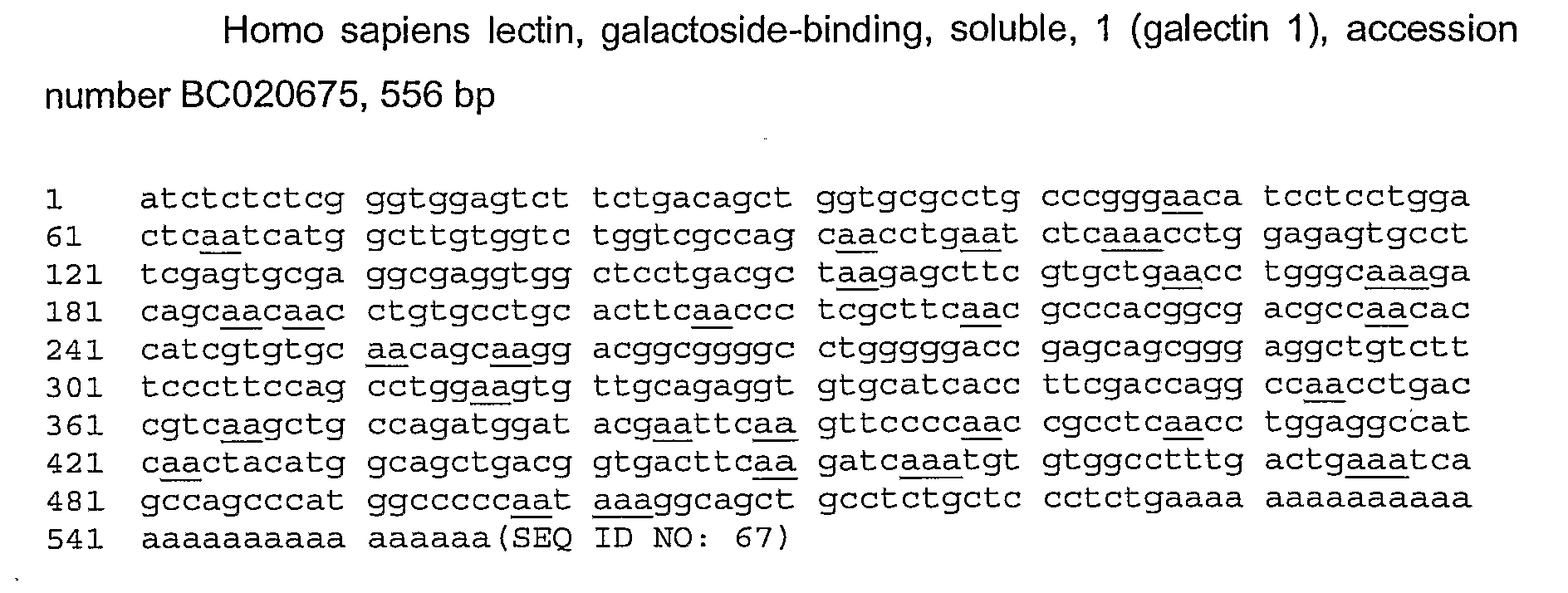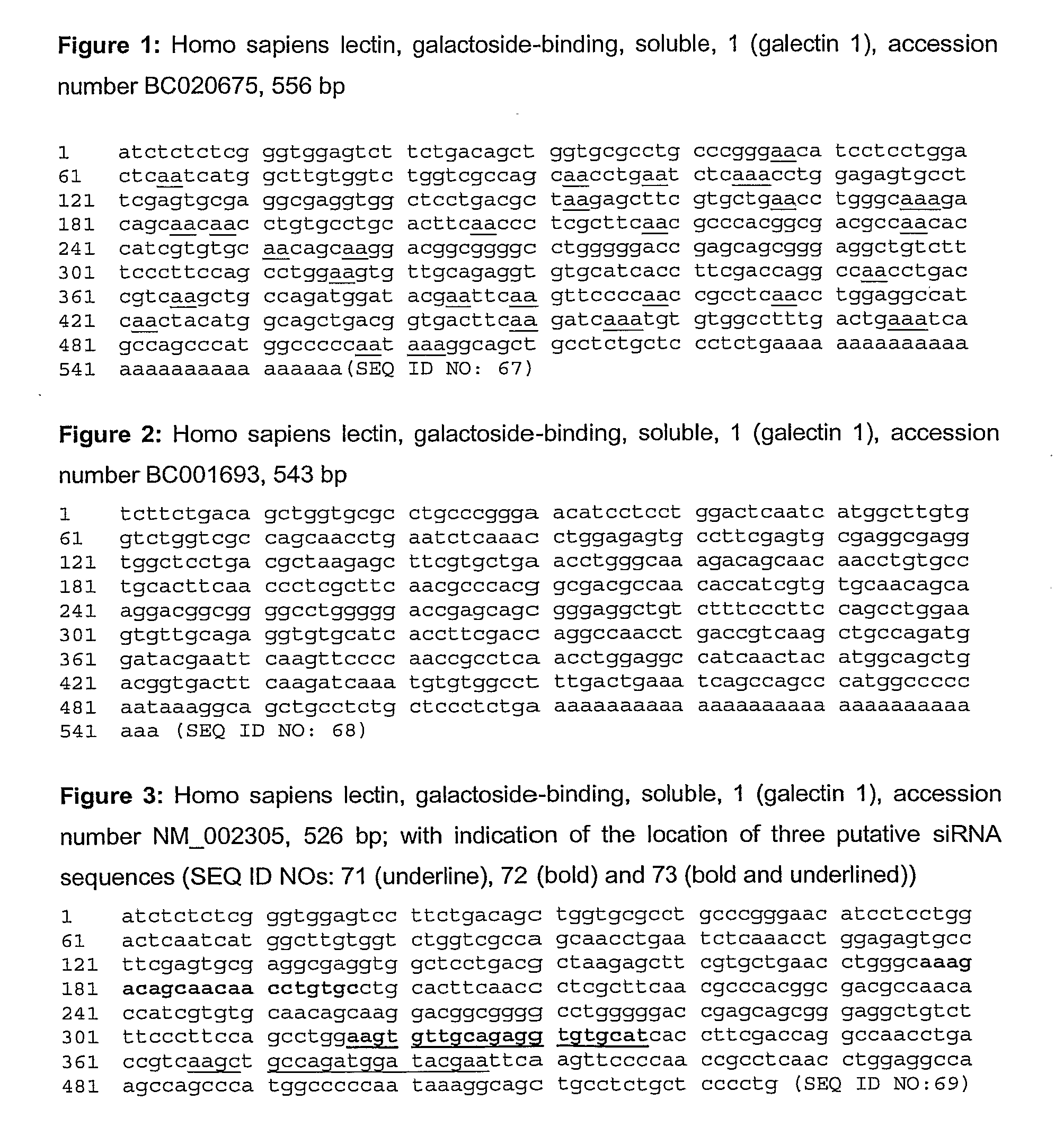Use of a galectin-1-targeted rnai-based approach for the treatment of cancer
- Summary
- Abstract
- Description
- Claims
- Application Information
AI Technical Summary
Benefits of technology
Problems solved by technology
Method used
Image
Examples
example 1
Examples of siRNA Sequences Targeted Against Galectin-1
[0155]Three sequences of human galectin 1 (from GenBank) were compared, including the sequence having accession number BC020675 (FIG. 1), BC001693 (FIG. 2) and NM—002305 (FIG. 3). Besides differences in length, NM—002305 differs from the two other sequences at 2 positions: an insertion of a C at position 19 and absence of a T at position 524. These differences have no consequences for the identification of RNAi molecules in accordance with the present invention. 33 “AA” doublets could be found in the representative sequence from BC020675 (SEQ ID NO: 67), as underlined in the sequence of FIG. 1.
[0156]Based on these sequences 33 putative DNA nucleid acids suitable for preparing siRNA sequences of human galectin-1 were identified and defined as SEQ NOs: 70-101; including:
aaatcagccagcccatggccc,(SEQ ID NO: 70)aagctgccagatggatacgaa,(SEQ ID NO: 71)aaagacagcaacaacctgtgc,(SEQ ID NO: 72)aagtgttgcagaggtgtgcat,(SEQ ID NO: 73)aacatcctcctggac...
example 2
Examples of shRNA Molecules According to the Invention
[0160]In this example, anti-galectin-1 shRNA sequences were cloned in the plasmid vector described and published by Dr. D. Takai (Department of Respiratory Medicine, University of Tokyo, Japan, Matsukura et al. 2003).
[0161]The shRNA expression vectors were constructed based on the siRNA-1 and siRNA-3 sequences as described above. Nucleotides sequences have been added upstream and downstream to the siRNA sequence for cloning purposes and shRNA expression. The end products obtained in the cytoplasm of cells by means of such type of constructs are similar to the sequences of siRNA-1 and siRNA-3. The sequences inserted in the plasmid vectors were checked by sequencing parts of the plasmids.
[0162]These vectors were co-transfected with a GFP reporter vector coding for the green fluorescent protein in the U373 glioblastoma model. Galectin-1 expression in these cells was detected by fluorescent immunocytochemistry. The results are illust...
example 3
In Vivo Experimental Delivery of Anti-Galectin-1-Based RNAi Molecules
[0163]To prove that the in vivo delivery RNAi-related compounds against galectin-1 may be beneficial for patients with malignant gliomas, clinically relevant experimental models are needed. These models have been developed and concern the orthotopic graft of malignant rat or human glioma in the brain of conventional or nude mice or rats (Lefranc et al. 2002; Branle et al. 2002, Lefranc et al. 2003, Lefranc et al. 2004).
[0164]The clinical practice for glioma is usually a surgical resection of the tumor mass followed by adjuvant therapeutics that tend to combat the remaining infiltrative and migrating cells, responsible of the very pejorative prognosis of these tumors. To be as close as possible to the clinical practice of glioma, the glioma developing into the brain of mice or rats because of the orthotopic grafts of glioma cells is surgically resected and adjuvant experimental RNAi treatment is administrated either...
PUM
| Property | Measurement | Unit |
|---|---|---|
| Electrical resistance | aaaaa | aaaaa |
Abstract
Description
Claims
Application Information
 Login to View More
Login to View More - R&D
- Intellectual Property
- Life Sciences
- Materials
- Tech Scout
- Unparalleled Data Quality
- Higher Quality Content
- 60% Fewer Hallucinations
Browse by: Latest US Patents, China's latest patents, Technical Efficacy Thesaurus, Application Domain, Technology Topic, Popular Technical Reports.
© 2025 PatSnap. All rights reserved.Legal|Privacy policy|Modern Slavery Act Transparency Statement|Sitemap|About US| Contact US: help@patsnap.com



